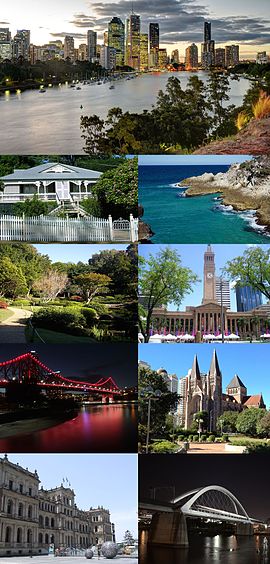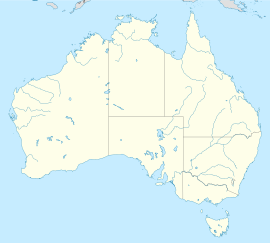
Back Брисбен Abkhazian Brisbane Afrikaans Brisbane ALS ብርዝበን Amharic بريزبان Arabic بريزبان ARY بريزبان ARZ Brisbane AST Brisben Azerbaijani بریزبین AZB
| Brisbane Meanjin Queensland | |||||||||
|---|---|---|---|---|---|---|---|---|---|
 | |||||||||
 Map of the Brisbane metropolitan area | |||||||||
 | |||||||||
| Coordinates | 27°28′S 153°02′E / 27.467°S 153.033°E | ||||||||
| Population | 2,360,241 (2016)[1] (3rd) | ||||||||
| • Density | 148/km2 (380/sq mi) | ||||||||
| Established | 13 May 1825 | ||||||||
| Area | 15,842 km2 (6,116.6 sq mi)[2] (2016 GCCSA) | ||||||||
| Time zone | AEST (UTC+10:00) | ||||||||
| Location | |||||||||
| LGA(s) | |||||||||
| Region | South East Queensland | ||||||||
| County | Stanley, Canning, Cavendish, Churchill, Ward | ||||||||
| State electorate(s) | 41 divisions | ||||||||
| Federal division(s) | 17 divisions | ||||||||
| |||||||||


Brisbane (Yagara: Meanjin, pronounced: [miˈændʒɪn]; local nickname Brissie) is the seaport capital city and biggest city of Queensland in Australia. It has a population of 2.2 million people and is the third biggest city in Australia, after Sydney and Melbourne.
The central city is on the Brisbane River, 23 kilometres (14 mi) inland from Moreton Bay.
Brisbane is named after the Brisbane River, which is named after Sir Thomas Brisbane who was Governor of New South Wales from 1821 - 1825.
A penal colony was founded at Redcliffe, 28 kilometres (17 mi) to the north, in 1824. It was moved to North Quay in 1825. The first free settlers moved to Brisbane in 1842. Brisbane became the capital city when Queensland became a separate colony from New South Wales in 1859.
Brisbane has more than 50 skyscrapers more than 100 metres (330 ft) tall.
- ↑ "Ten years of growth: Australia's population hot spots". Australian Bureau of Statistics. 28 July 2017. Archived from the original on 28 July 2017. Retrieved 4 August 2017.
- ↑ "2016 Census Community Profile – Greater Brisbane (3GBRI – GCCSA)". Australian Bureau of Statistics. Archived from the original on 2017-07-14. Retrieved 2018-01-25.; [1] Archived 2017-07-14 at the Wayback Machine, ZIPed Excel spreadsheet. Cover
- ↑ "Great Circle Distance between BRISBANE and SYDNEY". Geoscience Australia. March 2004.
- ↑ "Great Circle Distance between BRISBANE and CANBERRA". Geoscience Australia. March 2004.
- ↑ "Great Circle Distance between BRISBANE and MELBOURNE". Geoscience Australia. March 2004.
- ↑ "Great Circle Distance between BRISBANE and ADELAIDE". Geoscience Australia. March 2004.
- ↑ "Great Circle Distance between BRISBANE and PERTH". Geoscience Australia. March 2004.
